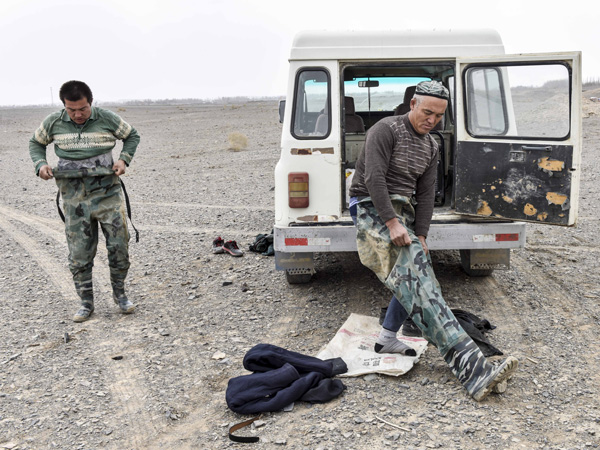Keeping the 'blood of Turpan' circulating
By Cui Jia (China Daily) Updated: 2015-04-16 07:49
|
|
'Fire State'
Turpan is the hottest and driest area of China. The highest ambient temperature on record in the area is 48 C, but in the Gobi Desert the surface temperature of the sand dunes can rise as high as 82 C, so it's no surprise to learn that Turpan is known as the "Fire State". The karez irrigation system was developed to prevent water evaporating at ground level.
The karez are fed by meltwater from the Tianshan Mountains. The water is filtered through sand and gravel at the foot of the mountains, before gravity carries it through the karez to the oases that form where the canals resurface. The vineyards nourished by the icy water are said to produce the sweetest grapes in China, and the underground streams provide potable drinking supplies for the local people.
In 2009, a survey conducted by Chen's bureau found that Turpan had 1,108 extant karez, and that 278 of them still carried water. The others have either dried up or have partially collapsed, according to Chen, who added that the shorter karez range from 3 to 5 kilometers in length, while the longest stretch more than 10 km. A small oasis forms at the end of every karez.
The karez nicknamed "Midun" near Ablimit's village in Turpan's Shanshan county is still full of life and acts as a water source for nearby villagers.
Unclogging the karez is delicate work and the basic techniques employed have remained unchanged for centuries, although tractors have replaced donkeys as the motive power to lower people into the vertical maintenance shafts, and battery-powered headlamps have replaced oil lamps to illuminate the dark, dank tunnels. Everything else is done by hand.
The work has to be undertaken around April every year, ahead of the massive volume of meltwater that will flow down from the mountains after the spring thaw. The work is of prime importance to the locals, and it must be done thoroughly to prevent the canal from becoming clogged and blocking the flow of water.
"Midun is not a difficult karez to clean, but some are more than 70 meters deep and extremely narrow, so we have to stoop and work on our knees," Ablikim said. The 29-year-old, who has spent the last 10 years as his father's apprentice, uses the pickaxe-shaped tool, designed for digging mud and widening the canal, that belonged to his grandfather.
He said the work is dangerous because the ancient structures can collapse at any time, and without warning. "It's hard to imagine how many people have lost their lives constructing and maintaining the karez."
Ablikim and his father repeatedly loaded the soggy mud into a basket, which was then lifted up through the shaft. Working together, they can remove 2 to 3 metric tons of mud and dirt from Midun every day.
People who know how to maintain karez have become great assets for Chen's team, which has been renovating the ancient irrigation system since 2009. "We call them 'karez craftsmen' whose skills are passed down from generation to generation. There are many of them in Turpan's villages and they are key for future renovation projects," he said.
So far, more than 600 km of the underground canals have been reinforced, and more than 10,000 vertical shafts have been repaired. Preparations for the renovation of 15 more karez are underway and the work will start later this year, according to Chen.
In addition to government funding, the contractors hired to build the high-speed railway that links Turpan and Urumqi, the regional capital, have also allocated special funds to reinforce karez near the railway link, which came into operation in November, to ensure they will be able to withstand the vibrations caused by the trains.
The openings of the maintenance shafts, which also allow water to enter the canals, can be seen dotted across the Gobi Desert in Turpan. They are a constant reminder to the locals that more than 5,000 km of the "Great Underground Wall of China" lie just below their feet.
- Govt encourages people to work 4.5 days a week
- Action to be taken as HIV cases among students rise
- Debate grows over reproductive rights
- Country's first bishop ordained in 3 years
- China builds Tibetan Buddhism academy in Chengdu
- Authorities require reporting of HIV infections at schools
- Typhoon Soudelor kills 14 in East China
- Police crack down on overseas gambling site
- Debate over death penalty for child traffickers goes on
- Beijing to tighten mail security for war anniversary








